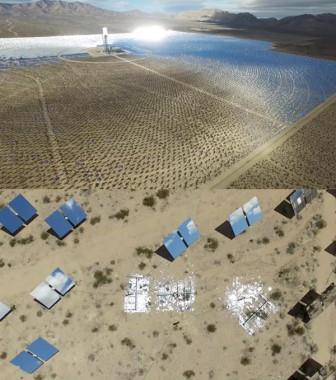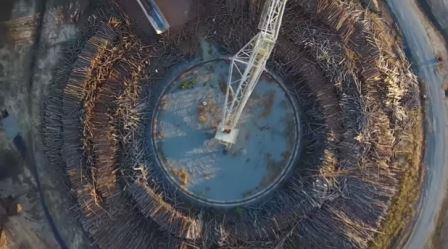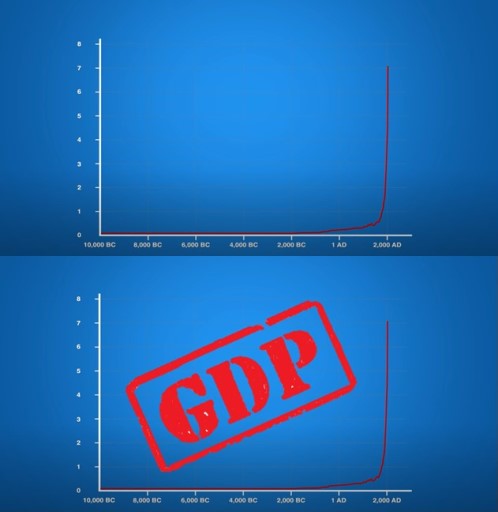Planet of the Humans is a once-in-a-decade documentary for all concerned with the environment, the economy, and life on Earth. Directed by Jeff Gibbs and produced by Michael Moore, Planet is especially important for advancing the steady state economy. It is reminiscent of Pope Francis’ Laudato si’ in that it makes the case for a steady state economy—resoundingly—while never quite uttering the phrase “steady state economy.”
When viewing a documentary, a political scientist will mind whose ox is being gored. In Planet, entire teams of oxen are gored, including sacred cows. Wind, solar, and biofuels industries are gutted, exposing rotten cores of corporate greed, co-opted NGOs, and an all-too-prevalent intellectual laziness of “green energy” groupies.
Big Environmentalism takes a heavy hit, too. The Nature Conservancy? Gibbs calls it “The Logging Conservancy.” Union of Concerned Scientists? “Union of Concerned Salesmen.” The Sierra Club comes out looking like some environmental Madison Avenue, dazed and confused about what side(s) it’s even on.
Gibbs doesn’t spare environmental heroes, either—not if he catches them with their fingers in the pie or their minds muddled with money. The heaviest hit are Bill McKibben and Al Gore, but Van Jones, Robert F. Kennedy, Jr., and various heads of the Sierra Club are pummeled as well.
Planet isn’t exclusively a downer with regard to leadership, though. In addition to Gibbs himself, Vandana Shiva comes out clean, and a star is probably born in the form of Ozzie Zehner, a visiting scholar at Northwestern University. Zehner’s mastery of the “green energy” terrain, along with a natural ease in front of the camera, should bring him to the forefront of planning and policy for our energy and environmental futures.
Let’s take a closer look at the sacred cows, their fresh wounds, and the lasting lessons from Planet of the Humans.
Green Energy—“It wasn’t what it seemed.”
While Planet is pitched as a Michael Moore production, it’s really the brainchild of director and narrator Jeff Gibbs, a long-time student and activist in environmental affairs. Gibbs has taken a deep dive into the technics, economics, and politics of energy extraction and marketing. As with most environmental activists, he was naturally inclined to support the movement toward renewable energy development. Surprises laid in store, however. As Gibbs put it, “Everywhere I encountered green energy, it wasn’t what it seemed.”
You’ll see exactly what he means as he canvasses the various businesses, industries, and environmental organizations assembled at “green” energy conferences. The mini-interviews he conducts with folks staffing the booths are full of cringe-worthy moments. Many of the sales representatives and industry spokespersons have no clues whatsoever about what their products are made of. Neither they nor the activists get it about energy return on investment or the net environmental effects of “green” energy.
Few of them know, for example, that a single wind tower requires over 60 truckloads of concrete at the base and needs its own acre to operate in. One tower takes hundreds of tons of steel and several tons each of copper, aluminum, and rare earth elements. It takes around $4 million to install one, and the net energy savings of wind projects are very much in doubt. Factoids and lists such as these make little impression on paper; Gibbs’ genius is bringing us to a site of “mountaintop removal for wind.” Pay keen attention to the ratio of environmental destruction to electricity served up, noting that the site you are visiting vicariously will seat only 21 turbines!

Ivanpah Solar Power Facility: ecologically economic? (Gibbs, Jeff, director. Planet of the Humans. YouTube, uploaded by Michael Moore, 21 April 2020)
|
Folks at the “green” energy conferences might also tell you that solar panels are made of “sand”—easy to come by, cheap as dirt! Yet it’s not the sand of vacant lots or empty backwoods (if you can find any such woods) that goes into solar panels, but rather highly refined quartz, plus the sodium hydroxide and hydrofluoric acid required in manufacturing the panels. And how much space does a solar array require? The Ivanpah Solar Power Facility, which opened in 2014 at a cost of $2 billion, required 3,500 acres and was supposed to power 140,000 homes, but already shows ominous signs of wear and tear.
The dull surprise behind these wind and solar follies is the constant idling (as opposed to shutdown) of fossil-fueled, base-load power plants. The sun goes down predictably, but clouds are less predictable, and winds literally come and go. Not so with the appliances, computers, entertainment paraphernalia, and “green” cars plugged into the grid, much less the pumps, generators, and communications infrastructure at the local and regional utilities and manufacturing plants. So, the grid is kept running, and not by “green” energy. As described by an energy consultant interviewed in Planet, “You’ve got to have a fossil fuel power plant backing it up and idling 100% of the time. Because if you cycle up or cycle down, as the demand on the wind comes through, then you actually generate a bigger carbon footprint than if you just ran it [the fossil-fueled power plant] straight.”
As Zehner put it, we would have been “better off just burning the fossil fuels in the first place, instead of playing pretend.” Taken out of context, such a statement might sound flippant, yet it was more like the bottom line of a thorough analysis of costs and benefits, including, for example, how much fossil fueling is required for the construction, maintenance, and de-commissioning of “green” energy projects.
Now please, don’t even think of accusing me, of all people, of pandering to fossil fuel interests. I wrote, for example, “BP: Beyond Probabilities” and that was ten years ago! Solar and wind projects have clear environmental advantages over coal-fired and nuclear power plants as well as fracking and tar sands mining. The point, though, is that the “green” energy industry is a charade if we think it will solve the sustainability problem without ever addressing the unsustainable demands of the human economy.
The take-downs of wind and solar power are persuasive and resonant, but Gibbs saves his goriest goring for the oxcart of biofuels. For a conservation biologist like me, biofuels have always seemed like a sham, especially as a form of “green” energy. One of my roles while serving at U.S. Fish and Wildlife Service headquarters was “biomass coordinator” for the National Wildlife Refuge System. Frankly it was an unwelcome role, and I can tell you that the only green aspect of biofuels is the color of the leaves headed for the chipper. As Gibbs points out in his plain-spoken but insightful way, “Wood chips, which is just a euphemism for trees, are being exported to Europe from America, British Columbia, Brazil and Indonesia.”

Logs headed to the wood chipper; thence the incinerator for “green” energy. (Gibbs, Jeff, director. Planet of the Humans. YouTube, uploaded by Michael Moore, 21 April 2020)
|
In the USA, too, entire groves, woodlands, and forests are headed for the incinerator in the “green” attempt to fuel the economy. That’s in addition to all the trash, dead animals, and even shredded tires that somehow qualify as “biofuels.” But the incinerators need any kind of fuel they can get to put a dent in the energy demand that comes with a $20 trillion GDP. Does any of that sound like “sustainable yield?” It’s another reminder that sustainability is first and foremost about size—in particular the size of the economy—and then about technological efficiency.
It’s hard to do justice to the comprehensiveness of the biofuels take-down in Planet. An entire review could be done just on that component, which addresses a plethora of technical, economic, and political nuances. I’ll leave it at this: If you are inclined to support the notion of biofuels as a significant energy source, you really must watch the film.
Fair to Gore and McKibben?
For steady staters, the world is no oyster. Ask yourself how many prominent figures you’ve heard explicitly advocating the “steady state economy.” Now contrast that with the multitude of figures and followers crowing for economic growth. Steady staters swim straight upstream in the river of political economy, with Big Money rushing relentlessly over us. Therefore, when a prominent figure comes along and signs the CASSE position on economic growth, we’re reluctant to take part in the bashing thereof. Friends are hard enough to find.
Bill McKibben signed the CASSE position in 2009 at the Powershift conference in Washington DC, where he and Gus Speth greeted enthusiastic young students following a session. When McKibben signed the CASSE position, he said, “I love what you guys are doing,” and it was apparent from the pages of Deep Economy (2007) that he’d been aware of CASSE for years. After the Powershift conference, with the signatures of McKibben (and Speth) in hand, the CASSE network was encouraged by the prospect of wider acceptance. Surely McKibben, who ‘loved what we were doing,’ would be a powerful ambassador for the steady state economy. But disappointment followed as news about McKibben never mentioned— because McKibben never seemed to mention—the steady state economy at all!
It’s hard not to notice, then, that numerous clips in Planet suggest McKibben got too far in bed with Big Money. His 350.org movement picked up steam—and for that he deserves credit—but naturally it attracted tempting suitors. McKibben found comfortable rafting in the river of political economy, as powerful corporate and political interests sidled up to him to get their slice of the “green” energy pie. By the time he was involved with the Green Century Fund, he was a de facto collaborator with mining corporations, oil and gas infrastructure companies, McDonalds, ADM, and Coca-Cola, along with a laundry list of banks. Advocating a steady state economy in that crowd would be like pushing for gun control at an NRA convention.
Fortunately, the verdict (for whomever may judge) is far from in on McKibben. People get in over their heads all the time; the best of them get back out and onto the solid ground they came from. Our bets are on McKibben. Going forward, he will have plenty of opportunities to clarify—as he once did by signing the CASSE position—that there is a fundamental conflict between economic growth and environmental protection. He can clarify, in other words, that sustainability is not some newfangled energy technology but rather a steady state economy with stabilized population and per capita consumption.
Al Gore will forever remain a mystery with regard to the net effects of his politics. During my Ph.D. research in the 1990s, and especially with my minor in political science, Gore was one of my biggest heroes. Earth in the Balance (and later An Inconvenient Truth) probably did more to raise awareness of environmental perils than anyone aside from perhaps Rachel Carson. Eventually, however, I caught on to the fact that Gore was also one of the world’s leading proponents of “sustainable growth,” the oxymoronic bane of the steady-state program. Along with Bill and Hillary Clinton, Gore favored the win-win rhetoric that “there is no conflict between growing the economy and protecting the environment.”
The CASSE network, myself included, has tried on many occasions to reach Gore and encourage him to come clean on the fundamental conflict between economic growth and environmental protection. Not that it’s easy to contact vice presidents while you’re swimming for your life in the river of political economy, trying not to drown while Big Foundation Money is funding all the win-win rhetoricians, keeping them more than afloat. But we’ve tried when we could, given the contacts available to us. Our guess is that Gore is quite familiar, by now, with the steady state economy as the sustainable alternative to growth. His intransigence in sticking with the win-win rhetoric tells us plenty.

Orangutan in a clear-cut rainforest. Reality, analogy, and sadness. (Gibbs, Jeff, director. Planet of the Humans. YouTube, uploaded by Michael Moore, 21 April 2020)
|
In Planet, then, we see the sad demise of a surely well-meaning but ultimately corrupted, win-win politician. The segment on “Blood and Gore” is most telling. Gore teamed up with David Blood (who spent 18 years at Goldman Sachs) to establish Generation Investment Management, known most notoriously for its investment in Brazilian sugar cane, where the industry creates severe pollution problems and pushes indigenous Amazonians straight out of their very cultures. The last scene of Gore, cynically defending the hypocrisy of his financial life, has to be one of the saddest clips in the film, albeit not as sad as the very last scene of the film, with the orangutan down to one last tree in a rainforest devastated for logs and biofuel and to make way for more sugar cane.
Big Environmentalism—Why Keep Our Memberships?
Unlike the big environmental NGOs, Gibbs and his guests “go there” on population and consumption issues. They both plop out of the bag a little over 19 minutes in, when an environmental consultant, skeptical about “green” energy, says, “Not being judgmental and not playing God, but we’ve got to deal with population growth and sustainable resources. We’ve all got to cut back.” From then on, population and consumption become the underlying—and eventually the overarching—themes.
The most prominent coverage of population and consumption appears in the alarming graphical display of these two variables skyrocketing since the industrial revolution. Reflecting on the rapidity and enormity of these trends, Gibbs states, “And that is the most terrifying realization I have ever had.”
We wish only that Gibbs had connected these themes of population and consumption with the single most policy-relevant phrase: GDP. Over the years, this has been one of our top priorities at CASSE; to get well-meaning activists and scholars to move beyond relatively impotent (and frankly obvious) warnings about population and connect it with the metric—GDP—that is central to the policy maker’s mind on Capitol Hill, in the White House, at the Fed and in the World Bank. We can lament population growth until we’re blue in the face, but as long as the fiscal and monetary levers are all set for GDP growth, incentives will be devised, installed, and maintained for population and consumption growth. That’s how public policy works: Incentives are provided to accomplish goals. And the #1 domestic policy goal, perhaps of all time, is GDP growth!

Gibbs’ population × consumption graph (top). Same graph with CASSE’s GDP Stamp, and with ten times the policy implications (bottom). (Gibbs, Jeff, director. Planet of the Humans. YouTube, uploaded by Michael Moore, 21 April 2020)
|
Not that Gibbs is oblivious to the connection. Approximately 70 minutes in, while skewering billionaire Michael Bloomberg and his supposedly “Beyond Coal” campaign, Gibbs does hit the nail on the head by recognizing, “the reason we’re not talking about over-population, consumption, and the suicide of economic growth, is that would be bad for business. Especially the cancerous form of capitalism that rules the world, and now hiding under a cover of green.” We only wish he had driven home that singular point about economic growth—coupled with “GDP” as the measure thereof— again and again and again.
Speaking of “bad for business,” now is the time to remind Big Environmentalism of a challenge it has thus far skirted. On September 18, 2018, I challenged the presidents of the Big 10 American environmental organizations—The Nature Conservancy, National Wildlife Federation, Sierra Club and others— to a debate on the topic: Is there a conflict between economic growth and environmental protection? While none of them stepped up to the plate, we have certainly noticed some decline in the win-win rhetoric, at least around the Washington, DC beltway.
On the other hand, some NGO representatives and board members have stubbornly stuck to the destructive nonsense that “there is no conflict between growing the economy and protecting the environment.” And, not a single one of the big NGOs has proactively handled the responsibility of raising awareness of limits to economic growth. Some do at times vaguely reference population, and even more vaguely consumption, yet “economic growth” and “GDP” are treated like elephants in the room. This is simply not good enough for NGOs who collected billions of dollars over the years from millions of members.
So, I have an idea. Let’s drop our memberships in these time-wasting, “green” energy pushing, corporately connected “environmental” NGOs and join, instead, organizations that explicitly raise awareness of limits to growth and call just as explicitly for the steady state economy! Or even “degrowth toward a steady state economy.” As the founder and now executive director of one such organization, I may be biased, but I may be right, too.
But don’t just listen to me. Listen very carefully to Jeff Gibbs and the cast of Planet of the Humans. You’ll be brought to the very doorstep of steady statesmanship!